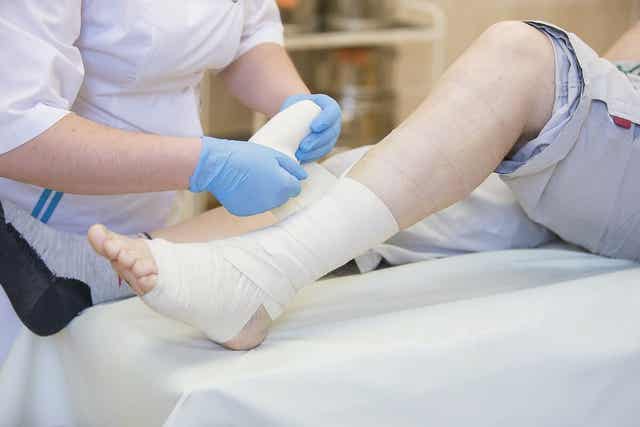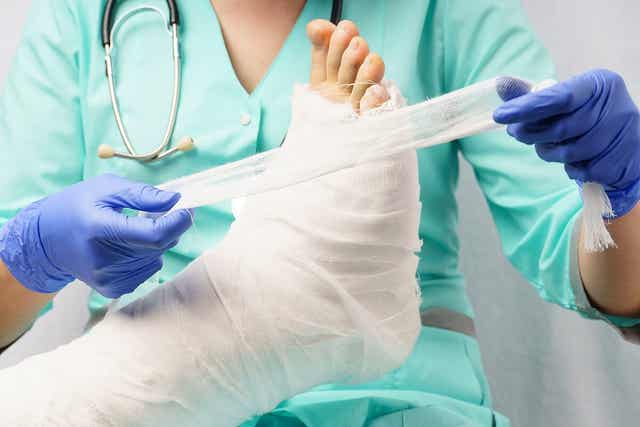Fiberglass or Plaster Casts: Which Is Better?

Although traditional plaster casts have been the most common option for fractures, fiberglass casts have had plenty of benefits for the last few decades for patients and healthcare personnel.
Despite the differences, each of these materials has its own advantages and disadvantages. Therefore, using one option or another depends on several factors.
Do you want to know more about this subject?
If so, keep reading!
Traditional plaster casts
From a historical point of view, this material has been the most widely used to immobilize fractured limbs. It’s made of semi-hydrated calcium sulfate, and it needs water to harden.
As a result of chemical reactions that use water, the plaster gradually releases heat, forms a paste, and hardens on the patient’s body. From then on, it won’t break as long as you follow the maintenance recommendations.

Find out more: Causes and Symptoms of Latex Allergy and its Treatment
The benefits of plaster casts
Plaster is readily available in almost any region, and it’s less expensive than fiberglass. This compliments the fact that many specialists were trained using this material. So, healthcare workers are more confident in their skills working with it.
Due to its semi-solid consistency, before it fully hardens, it’s easy to mold the cast to some parts of the body that are hard for health workers to cover. This is more important in patients with reduced mobility from a disability.
The disadvantages of plaster casts
If you’ve ever had a cast, you may remember the situation in the trauma room for these procedures. Plaster can stain almost any surface, requiring constant cleaning.
It’s also heavy and more uncomfortable compared to those made of fiberglass, something that can be difficult for children. Since plaster is fragile, it requires care to prevent it from disintegrating early. We’ll talk about it more in the next section.
Care for plaster casts
Having a traditional cast for several weeks can become uncomfortable. According to information from the Mayo Clinic, they recommend:
- Be careful not to get lots of water on it. A little liquid on the surface may not cause big problems, but if the water seeps into the interior, it can break the material and irritate the skin.
- When showing or bathing, you’ll need to use several plastic bags to stop it from getting wet.
- Unless a doctor says otherwise, you should keep the limb slightly elevated the first few days to prevent fluid from building up (edema). Keep it raised above your heart.
There’s some controversy about the trend of writing names or drawing pictures on casts. The truth is that, in some cases, it can promote skin irritation and weaken the material.
Fiberglass casts
The material is more modern and is known as “synthetic plaster.” The placement technique is quite similar to the previous one, and fortunately, it’s a cleaner procedure, which can be carried out in a more orderly way.
With both materials, you need to place a layer of cotton under the cast to protect the skin. in addition, it makes having a cast more comfortable. In some countries, it’s called wadding, and it can also act as a thermal insulator.
Find out more: Degrees and Types of Sprains
The benefits of fiberglass casts
Fiberglass has greater benefits for both the doctor and the patient. The most important are:
- Allows better visualization of bones during an X-ray. This is important to see how the fracture is progressing. This process is known as bone healing.
- It’s less heavy and more comfortable, so it’s easier to move.
- Some are resistant to moderate amounts of water, but they shouldn’t be exposed to too much.
- They’re usually durable.
All these benefits have caused it to replace traditional plaster casts in developed regions. However, it’s also still common in developing countries.
The disadvantages of fiberglass casts
Fiberglass is more expensive than plaster, which is the main disadvantage. However, considering its benefits, this hasn’t prevented it from being common around the world.
Although the external part is resistant to water, the inside could get damaged if constantly exposed. Also, this can irritate the skin and weaken the material.
Care for fiberglass casts
You can take care of this cast the same as plaster casts, taking into account the considerations on water. In addition, it would also be helpful to remember the following:
- You shouldn’t apply personal hygiene products to the edges of the casts, like deodorants or creams, without prior authorization from your doctor.
- Avoid making sudden movements and adjusting the cast without your doctor’s approval.
- This type of immobilization usually leaves some tissue visible in the most distal part of the limb. Keep an eye out for any change in color or sensitivity in the area, especially during the first hours.
Despite being resistant, and having greater benefits, you need to take care of it. It’s still a material that can deteriorate. Without proper care, it can lead to unnecessary medical visits.

What to take into account when choosing between fiberglass or plaster casts
The decision about what type of cast to use is often a medical decision, especially where certain resources are limited. However, tell your doctor or technical staff about the following situations:
- Allergy to any type of substance or history of contact dermatitis.
- Difficulties moving due to some type of previous condition.
- Desire to use a specific type of material.
In any case, there are some contraindications to completely rule out either of the two materials. Any other situation we didn’t mention in the list should be mentioned to the health personnel.
Fiberglass and plaster casts are safe, but you have to be vigilant
In general, complications after getting a cast are very rare. However, you need to see a doctor if you get annoying symptoms. The most important to look out for are pain and excessive swelling. After all, the goal of casts is to reduce these problems.
All cited sources were thoroughly reviewed by our team to ensure their quality, reliability, currency, and validity. The bibliography of this article was considered reliable and of academic or scientific accuracy.
- Técnicas externas de inmovilización en traumatología. AMF 2009;5(10):606-610.
- Aybar A. Clasificación en fracturas. Rev S And Traum y Ort 2012;29(1/2):10-23.
This text is provided for informational purposes only and does not replace consultation with a professional. If in doubt, consult your specialist.









